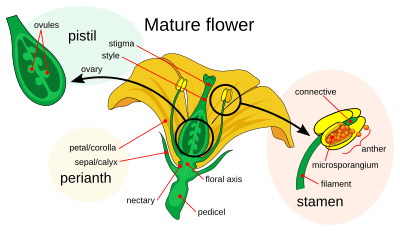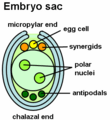Pollen tube facts for kids

The pollen tube is like a tiny tunnel that helps plants make seeds. It's the path that male plant cells (called sperm) travel from the pollen to reach the female egg cell. When the sperm reaches the egg, it's called fertilization, and this process creates new seeds.
For most plants that make seeds, the pollen tube acts as a special delivery system. It carries the sperm cells from the pollen grain. In flowering plants, this journey starts from the stigma, which is the sticky top part of the flower. The pollen tube then grows down to the ovules, which are like tiny eggs located at the bottom of the flower's pistil.
In flowering plants (also known as angiosperms), the pollen tube starts to grow from the pollen grain. It grows all the way through the stigma, down a stalk called the style, into the ovary, and finally reaches the eggs inside the ovules. For example, in corn, this single cell can grow more than 12 inches long to travel through the pistil! The sperm cells themselves can't move, so the pollen tube carries them along.
Contents
How Plants Reproduce: The Pollen Tube's Role
When the tip of the pollen tube reaches an egg, it bursts open. This releases two sperm cells. This is part of a special process called double fertilization.
Double Fertilization Explained
Here's what happens during double fertilization:
- One sperm cell joins with the egg cell. This creates the embryo of a new plant. This embryo is the tiny plant that will grow inside the seed.
- The second sperm cell joins with another part of the ovule called the central cell. This forms the endosperm of the seed.
What is Endosperm?
The endosperm is a very important part of the seed. It's packed with energy, like starch, proteins, and oils. Think of it as food for the growing plant embryo. It's also a major food source for humans! Many of our staple foods come from the endosperm of seeds, such as wheat, barley, rye, oats, and corn.
Images for kids
See also
 In Spanish: Tubo polínico para niños
In Spanish: Tubo polínico para niños






